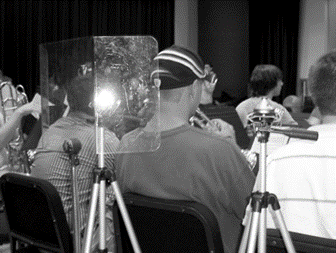Shields, Screens, and Baffles
In the Music Research Institute (MRi) at the University of North Carolina Greensboro, we seek any and all approaches to educate about, and get musicians to use hearing protection. We have little difficulty convincing musicians, that in certain music situations, they need to use hearing protection (we let the decibels and sound doses tell the story). However, getting musicians to use hearing protection is quite a challenge. For reasons most of us understand, one being risking less than optimal performance, musicians resist wearing earplugs. Enter the option of using acoustic shields, screens, and baffles.

Figure 1. North Carolina Symphony shield with dose Badges, shield-protected and not shield-protected, for sound-level measurement.
Just as the individual musician controls the use of earplugs, nearly all of the commercially available acoustic shields are designed for individual use. Many of the designs allow for changing height and angle of the shield. Shields seemed a useable alternative, so we decided to acquire and test a few models. The models tested included the Manhasset Acoustic Shield, the Wenger Acoustic Shield, and shields that were custom made for the North Carolina Symphony (base of a Manhasset stand with tri-panel plexiglass as the shield, seen in Figure 1).1
Results – Shields Work (in most cases)
When we studied sound doses using shields (for individuals – not as distant barriers or sound reflection), the results were mixed, as results usually are. In short, the shields (all three models) reduced sound levels/doses for individuals in some, but not all environments.
The head of the shield-protected musician must remain ≤ 4 inches, and closer is better. At distances greater than 4 inches from the shield, protection is diminished to the point that the shield no longer functions as desired. It isn’t easy for a musician to sit still, but if they choose to use an acoustic shield, that is what they need to do.
When musicians were seated close to each other, and in relatively small rehearsal venues, the sound levels/doses were greater when using baffles/shields than when not using them. Without sufficient space between the shield-protected musician and other sources of sound, shields functioned as reflective surfaces directing more sound to ears of the user. In small venues, musicians should use earplugs, because they simply cannot get away from the sound sources.

Figure 2. Wenger Acoustic Shield.
What the Musicians Prefer
Musicians reported that they preferred the relatively small, and angled or wrap around design. They felt that they could “get inside” the protected area. The shield of choice was the custom-designed North Carolina Symphony shield (see Figure 1).
Because of the maneuverability of the Wenger Acoustic Shield (Figure 2) musicians preferred its stand base.2 However, the Plexiglass shield was larger than the musicians preferred.
The Manhasset Acoustic Shield (Figure 3) doubles as a conductor's stand, so it is quite large (66 × 60 cm). In local orchestras, I have witnessed musicians use three or more of these as a wall-type barrier between brass and strings, and percussion and strings. They also use them to reflect sound for the horns. As of yet, I have not seen any local musicians using these as individual sound shields.
Figure 3. Manhasset Acoustic Shield.
http://www.wengercorp.com/stands/acoustic-shield.php
Other Commercially Available Shields
Although the North Carolina Symphony shield is not available for purchase, the K&M-11900 Sound Insulation Stand is similar in design (Figure 4). The RAT Acoustic Screen provides positional options similar to that of Wenger, and the Kolberg Sound Screen provides the largest shield surface of 100 × 60 cm.
Figure 4. K&M Sound Isolation Stand, RAT Acoustic Screen, and Kolberg Sound Screen.
K& M url - http://produkte.k-m.de/en/product?info=54&xd609e=mq1cjjac3hr98tlb5m4kf5lac2
RAT url - http://www.ratstands.com/rat_acoustic_stands.html
Kolberg url - http://products.kolberg-percussion.com/en_GB/150/product/4586.html#
The Wilde & Spieth Padded Acoustic Shield and Goodear Acoustic Shield (Figure 5) appear as if they would be effective, and attractive. However, the shields are not transparent, thus some orchestras may think them to be an obstacle for musicians, and possibly detract from the experience of the audience.
Figure 5. Wilde & Spieth Padded Acoustic Shield and Goodear Acoustic Shield.
Wilde url - http://www.wilde-spieth.de/index.php/sound-insulation-element.html
Goodear url - http://symphonyinternational.net/products/ohs/
The Amadeus Acoustic Shield (Figure 6) is designed as a double layer shield with a perforated layer acting as a sound diffuser. This model is fixed to the frame of chairs specific to the Amadeus company, and allows for no position options.
Figure 6. Amadeus Acoustic Shield.
Amadeus url - http://www.amadeus-equipment.co.uk/acoustic-shields/
Considerations
As seen above there exist commercially available acoustic shields, screens, and baffles. However, when working with musicians, it is important to discuss environments in which shields are appropriate, whether specific shields will allow proper performance posture, and when earplugs would the better option. And please remind musicians that the “best” hearing protection is the one they will use.
References
- Libera RCH. Shielding a musician: a case study on the effectiveness of acoustic shields in live ensemble rehearsals. 2009. Available at: http://libres.uncg.edu/ir/uncg/listing.aspx?id=1876
- Libera R. and Mace S. Shielding sound: a study on the effectiveness of acoustic shields. Journal of Band Research 2010;45:2.

